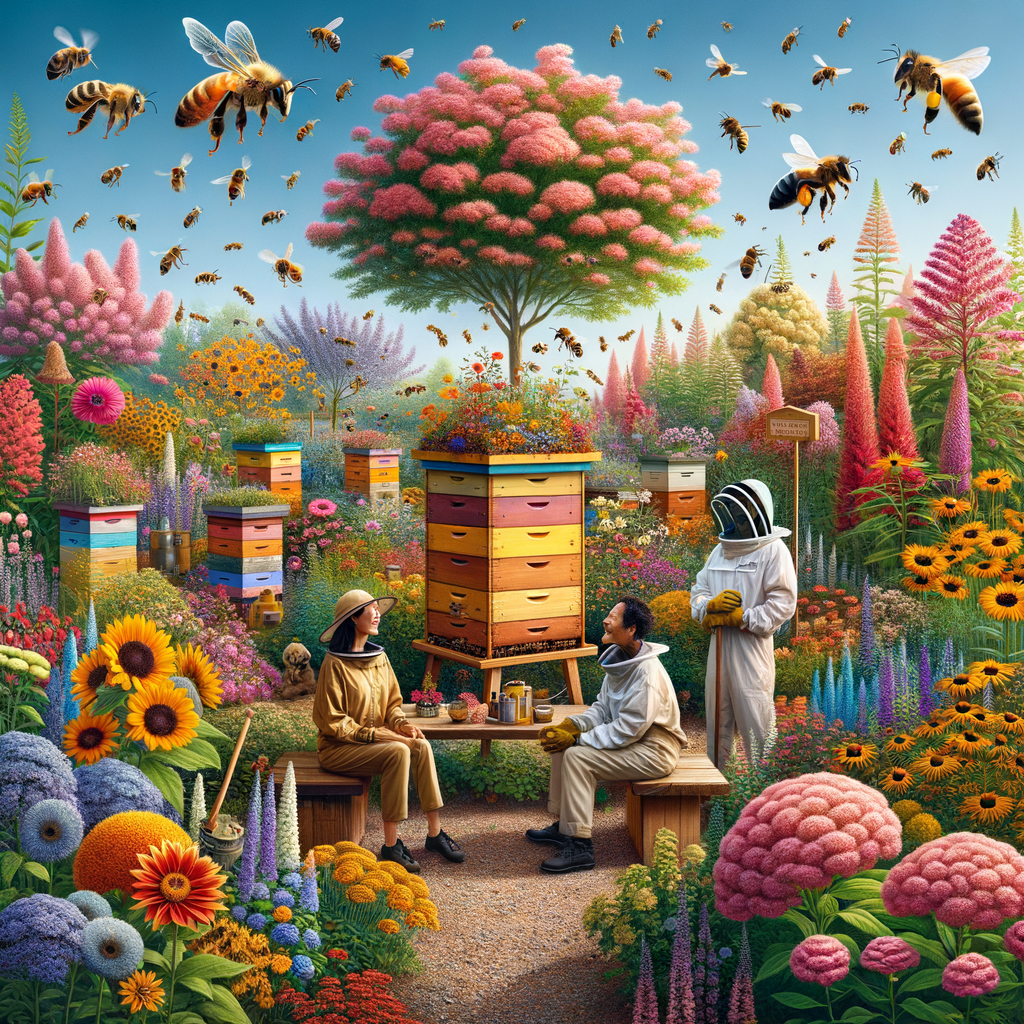
Introduction to Beehive Health
Bees are a vital part of our ecosystem. They pollinate flowers, which helps plants to grow, breed, and produce food. They also create honey, a natural sweetener that humans have enjoyed for thousands of years. But to do all this, bees need to be healthy. And the health of a bee is largely determined by the health of its hive.
- Understanding the Importance of Beehive Health
- Factors Affecting Beehive Health
The health of a beehive is crucial for the survival of bees and the ecosystem they support. A healthy hive is a bustling city of activity, with bees carrying out various roles to support the colony. The queen bee lays eggs, worker bees gather food and maintain the hive, and drone bees mate with the queen. If the hive is unhealthy, these roles can’t be performed effectively, leading to a decline in the bee population.
Several factors can affect the health of a beehive. These include the availability of food, exposure to pesticides, diseases, and parasites, and changes in the environment. For instance, a lack of floral diversity can limit the bees’ diet, affecting their health and productivity. Similarly, exposure to certain pesticides can harm bees, while diseases and parasites can spread rapidly in a hive, decimating the bee population.
As we delve deeper into this topic, we will explore the power of floral diversity, provide beekeeping tips for hive health improvement, and share case studies on the impact of floral diversity on beehive health. By understanding these aspects, we can all play a part in boosting beehive health and preserving our precious bee populations.
The Power of Floral Diversity
Floral diversity, or the variety of flowers in a given area, plays a crucial role in our ecosystem. It is particularly significant for our buzzing friends, the bees. Let’s delve into the importance of floral diversity for bees.
Importance of Floral Diversity for Bees
Bees are not just honey producers; they are vital pollinators that contribute to the growth and survival of various plants. The diversity of flowers in their environment directly impacts their health and nutrition. Here’s how:
- Role of floral diversity in enhancing bee health
- Impact of flower variety on bee nutrition
Bees need a balanced diet to stay healthy, just like us. A diverse range of flowers provides bees with a mix of nectar and pollen, each with different nutrient profiles. This variety helps boost their immune system and resistance to diseases. A study by the University of Bristol found that bees with access to a wide range of flowers were healthier and lived longer.
Each flower species has a unique nutritional profile. By having access to a diverse range of flowers, bees can get a balanced diet. For instance, sunflowers offer high protein pollen, while clover provides carbohydrate-rich nectar. This diversity ensures bees get all the nutrients they need for growth, reproduction, and survival.
In conclusion, floral diversity is not just a feast for our eyes but also a lifeline for bees. By promoting a diverse range of flowers in our gardens and landscapes, we can help enhance bee health and nutrition, contributing to a healthier and more vibrant ecosystem.
Bee-Friendly Flowers: Maximizing Hive Health
Flowers play a significant role in the health and productivity of a beehive. They provide bees with the nectar and pollen they need to survive and thrive. However, not all flowers are created equal when it comes to bee-friendliness. Let’s explore how to identify bee-friendly flowers and create a diverse pollinator garden.
- Identifying Bee-Friendly Flowers
- Creating a Pollinator Garden with Diverse Flowers
Recognizing bee-friendly flowers is the first step towards maximizing hive health. Bees are particularly attracted to flowers that are blue, purple, and yellow. They also prefer flowers with a single layer of petals, as they can easily access the nectar and pollen. Some examples of bee-friendly flowers include lavender, sunflowers, and daisies.
| Flower | Color | Petal Layer |
|---|---|---|
| Lavender | Purple | Single |
| Sunflower | Yellow | Single |
| Daisy | White | Single |
Once you’ve identified bee-friendly flowers, the next step is to create a diverse pollinator garden. A diverse garden has a variety of flowers that bloom at different times of the year, ensuring a constant food source for the bees. It’s also important to avoid using pesticides, as they can harm the bees.
Remember, a diverse garden isn’t just good for the bees; it’s also good for the environment. As Albert Einstein once said, “If the bee disappeared off the face of the Earth, man would only have four years left to live.”
Beekeeping Tips for Hive Health Improvement
As a beekeeper, one of your primary responsibilities is to ensure the health and vitality of your hive. This involves regular inspections and addressing common health issues that may arise. Let’s delve into these areas in more detail.
Managing Hive Health
Managing hive health is an ongoing task that requires vigilance and a proactive approach. Here are some key strategies:
- Regular Hive Inspections
- Addressing Common Hive Health Issues
Regular hive inspections are essential to maintaining hive health. These inspections allow you to monitor the bees’ behavior, check for signs of disease or pests, and ensure the queen is healthy and productive. It’s recommended to inspect your hive every 7 to 10 days during the active season.
Common hive health issues include pests like Varroa mites, diseases such as American Foulbrood, and environmental stressors like extreme weather or lack of food. Early detection and treatment are crucial to prevent these issues from escalating. For instance, Varroa mites can be managed with organic treatments like formic acid, while American Foulbrood may require the removal and destruction of infected frames.
Remember, a healthy hive is a productive hive. By implementing these strategies, you can help ensure your bees thrive and continue to contribute to our ecosystem.
Enhancing Bee Health with Floral Diversity
One of the most effective ways to boost the health of your bees is by enhancing the floral diversity in their environment. This not only provides them with a rich and varied diet but also strengthens their immune system, making them more resilient to diseases and pests. Let’s delve into the specifics of how you can achieve this.
- Choosing the Right Flowers for Your Region
It’s essential to choose flowers that are native to your region. These plants are already adapted to the local climate and soil conditions, making them more likely to thrive and provide a steady source of nectar and pollen for your bees. Some examples of region-specific flowers include the California Poppy in the West, the Black-eyed Susan in the East, and the Bluebonnet in the South.
Moreover, native flowers are more likely to attract native bee species, contributing to the overall biodiversity and health of the ecosystem. A study conducted by the University of Bristol found that honey bees prefer native flowers over non-native ones, indicating their importance in a bee-friendly garden.
- Seasonal Considerations for Floral Diversity
Another crucial factor to consider is the changing seasons. Bees need a continuous food supply from early spring to late fall. Therefore, it’s important to have a mix of flowers that bloom at different times of the year. This ensures that your bees have access to a diverse range of nutrients throughout the different seasons.
For instance, Crocuses and Snowdrops are excellent choices for early spring, while Sunflowers and Coneflowers are perfect for the summer. Asters and Goldenrods, on the other hand, bloom in the fall, providing a late-season feast for your bees.
Remember, a diverse garden not only benefits the bees but also creates a more vibrant and beautiful landscape for you to enjoy. So, start planning your bee-friendly garden today and contribute to the health and survival of these vital pollinators.
| Season | Flowers |
|---|---|
| Spring | Crocuses, Snowdrops |
| Summer | Sunflowers, Coneflowers |
| Fall | Asters, Goldenrods |
Case Studies: The Impact of Floral Diversity on Beehive Health
Let’s take a closer look at how floral diversity can positively impact beehive health. We’ll explore two case studies that highlight the importance of a varied flower diet for bees.
- Case Study 1: Increased Honey Production with Diverse Flowers
- Case Study 2: Improved Hive Health with Flower Variety
In a study conducted by a group of beekeepers in Oregon, USA, it was found that beehives surrounded by a diverse range of flowers produced significantly more honey than those in areas with less floral diversity. The beekeepers observed that the hives located near diverse flower fields produced up to 30% more honey. This is because bees can gather a wider range of nutrients from different types of flowers, which helps them to produce more honey.
In another study conducted in the French countryside, beekeepers noticed a significant improvement in hive health when the bees had access to a variety of flowers. The hives that were located near fields with a diverse range of flowers had fewer instances of disease and a lower mortality rate compared to those in areas with less floral diversity. The researchers concluded that the varied diet provided by the diverse flowers helped to boost the bees’ immune systems, making them more resistant to disease.
These case studies clearly show that floral diversity can have a significant impact on beehive health and honey production. By providing bees with a diverse range of flowers to forage from, we can help to improve their health and increase their honey production. This is an important consideration for anyone involved in beekeeping or agriculture.
| Case Study | Location | Outcome |
|---|---|---|
| Increased Honey Production with Diverse Flowers | Oregon, USA | Up to 30% increase in honey production |
| Improved Hive Health with Flower Variety | French Countryside | Lower disease rates and mortality in hives |
Key Takeaways: Boosting Beehive Health with Floral Diversity
In this article, we’ve explored the crucial role that floral diversity plays in maintaining a healthy beehive. We’ve also shared some practical beekeeping tips and steps to enhance the floral diversity for bees. Here are the key takeaways:
- Importance of Floral Diversity for Beehive Health
- Beekeeping Tips for Maximizing Hive Health
- Practical Steps to Enhance Floral Diversity for Bees
Floral diversity is vital for beehive health. Bees need a wide variety of flowers for their nutrition. Different flowers provide different nutrients, and a diverse diet helps bees resist diseases and parasites. A study showed that hives with access to a wide variety of flowers had a 45% higher survival rate than those with less diversity.
As a beekeeper, you can do several things to maximize hive health. Firstly, ensure your bees have access to diverse flowers. Secondly, avoid using pesticides as they can harm bees. Lastly, regularly check your hives for signs of disease or parasites and take action immediately if you spot any.
Enhancing floral diversity for bees is not as complicated as it may seem. You can start by planting a variety of flowers in your garden. Choose flowers that bloom at different times of the year to provide bees with a constant source of food. You can also encourage your neighbors to do the same, creating a bee-friendly community.
In conclusion, floral diversity is a simple yet effective way to boost beehive health. By understanding its importance and taking practical steps to enhance it, we can help our bees thrive.








